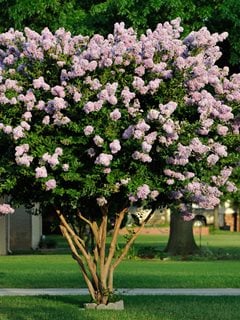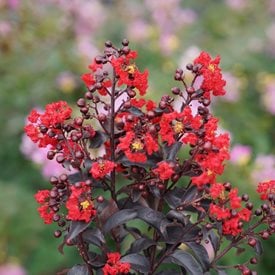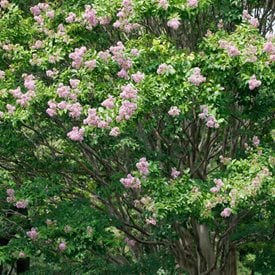How to Grow & Care for Crape Myrtle Trees & Bushes
Add a punch of late-summer and early-fall color by growing crape myrtle trees & shrubsCrape myrtle (or crepe myrtle) trees & bushes provide year-round interest and color with their showy summer flowers, colorful fall foliage and attractive exfoliating bark in winter. They are available in several sizes from 2-foot shrubby dwarf varieties to towering trees, offer many colors from white to shades of deep red and purple, and can be grown as single or multi-trunk specimens. With all of these options, you’ll be able to find the perfect crape myrtle for your garden.
On this page: Basics | Planting | Care & Pruning | Pictures | Design Tips | Frequently Asked Questions
- CRAPE MYRTLE BASICS
- PLANTING CRAPE MYRTLES
- CARE & PRUNING
- CRAPE MYRTLE PICTURES
- DESIGN TIPS
- FREQUENTLY ASKED QUESTIONS
CRAPE MYRTLE BASICS
Zones:
Varieties for zones 6-10. Some may only be root hardy in zone 6, meaning the roots will survive the winter temperatures, but it's possible that the above-ground branches will die back completely to the ground. If this occurs, new spring growth will emerge from below ground.
Height/Spread:
Standard single and multi-trunk trees can grow to 20 to 30 feet tall and 10 to 15 feet wide, quickly growing up to 3 feet per year. There are also smaller varieties at 6 to 12 feet tall, semi-dwarf varieties ranging from 3 to 6 feet tall, and dwarf shrubs 2 to 5 feet tall. Make sure you're choosing the appropriate crape myrtle bush or tree for your location and design.
Exposure:
Full sun, minimum 6 hours per day.
Bloom Time:
July to September, with some varieties blooming until first frost.
Flower Color:
Varieties available in white, and multiple shades of red, purple, and pink.
Invasive:
Some may seed aggressively in parts of the country. Check with local experts to see if planting is appropriate where you live.
Learn more: Where is this species invasive in the United States?
PLANTING CRAPE MYRTLE
When to plant:
As a general rule, most deciduous trees and shrubs are planted in fall or early spring, allowing them time to establish their roots before going dormant in winter or before the heat of summer hits. Crape myrtles are very resilient and can be planted most any time of year, even in summer — just be sure to water them well.
Where to plant:
Crapes love the sun and are extremely heat tolerant. They should be planted in an area with at least 6 hours of sunlight per day. Some partial shade during the day is fine, but may result in fewer blooms. More sun = more blooms. They aren’t picky about their soil, but do need good drainage.
How to plant:
Dig a hole twice as wide and just as deep as the container. Center the tree within the hole and backfill in stages, watering as you go. The top of the rootball should be slightly above ground level to allow it to breathe and take in oxygen. Stake if needed and water thoroughly after planting.
CARE & PRUNING
Pruning:
Crape myrtles bloom in late spring through summer on new growth, so pruning should be done in winter when they're dormant.
- Single-trunk trees: Reduce side branches that could compete with the leader, as well as "basal sprouts" that emerge from the base of the plant.
- Multi-trunk trees: Prune to shape, not allowing the individual trunks to become crowded or touch one another, and keeping the center slightly open to allow air and light in.
- Shrubs: For a more natural look, very little pruning is required other than to maintain healthy branches and to thin out as needed.
In addition to specific pruning for the shape of your tree or shrub, a good cleaning up in the winter is recommended. Remove any crossing or branches crowding the center, as well as any dead or diseased wood.
Keep pruning (and possible frustration) to a minimum by choosing one that will grow into the right size and shape naturally. Check the plant tag information to confirm the mature size and shape of your tree.
See more on how to properly prune crape myrtle trees.
Beware of over-pruning: A common mistake is over-pruning and lopping the tops off, frequently referred to as “crape murder.” This can result in your tree or shrub putting all of its energy into producing new branches and leaves, with very little energy left for blooms. Some say that this creates larger blooms the following season; however, larger bloom clusters on new branches can cause them to droop and break. Additionally, year after year, this creates knobby growth at the cut point that is more susceptible to disease and distracts from the beauty of the tree.
Deadheading:
Spent flowers can be trimmed during the growing season to promote a second blooming.
Soil:
Although crape myrtles can be grown in virtually any soil, foliage may turn yellow if soil is too alkaline. Good drainage is required for any type of soil.
Amendments & Fertilizer:
During the first growing season (spring/summer), lightly fertilize once a month. For established trees or shrubs, apply a slow-release fertilizer at the first signs of new growth in spring. Following that, apply a light feeding twice a month in spring and summer, as they are heavy feeders during their growing season. Be sure to water well after every application of fertilizer. Apply a good layer of mulch to protect the roots during winter in colder climates.
Watering:
Once established, crape myrtles are quite drought tolerant. During the first few growing seasons, they should be watered regularly and deeply once a week, or twice a week in extremely hot weather.
Diseases and Pests:
The main disease problems with crape myrtles are fungal leaf spot and powdery mildew. They do have some susceptibility to aphids and scale. Varieties such as the Rikki Tikki® and Center Stage™ series have been developed with increased resistance to powdery mildew.
CRAPE MYRTLE PICTURES
Featured in: Garden Design's Top 10 Garden Trends for 2022 ("Designing with Dark Foliage")
DESIGN TIPS
Crape myrtles make versatile additions to the garden, here are some ideas for how to use them:
- Use single specimens as a focal point.
- Use dwarf varieties as colorful additions in borders and beds.
- Plant multiple dwarf or medium-size crapes together to form a deciduous hedge.
- Dwarf varieties make excellent choices for large containers.
- Plant among spring-blooming trees to offer a mix of color starting in early summer.
- Their non-invasive roots make them good choices for street trees or near walkways and driveways.
- Plant in containers for annual color in colder zones (2-5) and over-winter indoors.
FREQUENTLY ASKED QUESTIONS
Why is my crape myrtle not blooming?
Newly-planted crapes may not bloom fully until their second season, so be patient if your crape is still establishing itself. Too much shade may also contribute to fewer blooms. Over-pruning can result in decreased flowering, as your tree’s energy will be spent on producing new branches instead of blooms. Too much water or fertilizer can cause foliage growth at the expense of bloom production.
Are crape myrtle roots invasive?
A crape myrtle’s roots may spread out a considerable distance; however, they are relatively weak and not aggressive. They do not produce heavy side roots that would cause damage to walkways, driveways, or foundations. Shallow crape myrtle roots may prove to be competition for water with surrounding grass.
Are crape myrtles poisonous?
Crape myrtles are listed as a safe plant according to the University of California, Davis. The ASPCA also lists them as being non-toxic to dogs, cats, and horses. For more safe plant choices, see 20 Common Plants Safe for Cats & Dogs.
Are crape myrtles deer resistant?
Although no plant can be determined completely deer proof, crape myrtles are rarely eaten by deer.
















